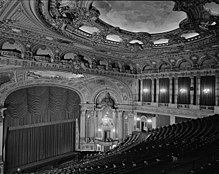Boston Opera House (1980)
| B.F. Keith Memorial Theatre RKO Keith's Theatre Savoy Theater |
|

The Boston Opera House, formerly the B.F. Keith Memorial Theatre (1970).
|
|
| Address | 539 Washington St. Boston, Massachusetts United States |
|---|---|
| Owner | Boston Opera House Ventures, LLC |
| Construction | |
| Opened | October 29, 1928 |
| Architect | Thomas W. Lamb |
| Tenants | |
| Broadway Across America and the Boston Ballet | |
| Website | |
| www |
|
The Boston Opera House is a performing arts venue located at 539 Washington St. in Boston, Massachusetts. Originally built as a movie palace, it opened on October 29, 1928 and was rededicated in 1980 as a home for the Opera Company of Boston. Completely restored in 2004, the theater currently serves as the home of the Boston Ballet and also presents touring Broadway shows.
The Boston Opera House was originally built as the B.F. Keith Memorial Theatre, a lavish movie theater in the Keith-Albee chain, The Keith's Memorial was designed by the prominent theater architect Thomas W. Lamb in one of his most elaborate designs. The theater was dedicated to the vaudeville pioneer B.F. Keith and opened October 29, 1928 presenting first run films along with live vaudeville. By 1929 the theater, now operated by RKO Theatres and called RKO Keith's, had converted to showing only films and remained a leading Boston movie showcase through the 1950s.
In 1965 the Sack Theaters company acquired the theater and renamed it the Savoy Theater. Sack later added a second smaller cinema in the theater's stage space, separated from the original auditorium by a masonry wall built across the proscenium.
In 1980, after closing as a movie house, the theater became the home of opera director Sarah Caldwell's Opera Company of Boston and was renamed the Boston Opera House. The theater was acquired and renovated by the opera company with the help of Boston arts patron Susan Timken. After a decade of innovative opera productions at the house, Caldwell's company collapsed due to financial troubles in 1991. Having previously produced opera since 1958 in rented theaters, the company was not financially prepared to cope with the substantial costs of upkeep for the large theater which had previously been poorly maintained for decades. The company's failure left the theater dark and without funds to maintain it.
Unheated, the building fell prey to extensive water damage, severely damaging the electrical system and the decorative plaster interior of the auditorium. The company's costumes, collected for decades and stored under the damaged roof, were lost. In 1996 the former opera company relinquished ownership of the building.
...
Wikipedia
